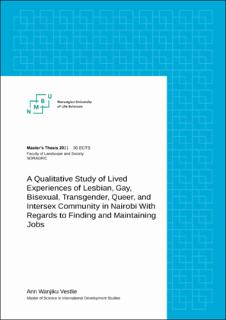| dc.contributor.advisor | Divon, Shai Andre | |
| dc.contributor.author | Vestlie, Ann Wanjiku | |
| dc.coverage.spatial | Kenya, Nairobi | en_US |
| dc.date.accessioned | 2022-02-28T15:22:07Z | |
| dc.date.available | 2022-02-28T15:22:07Z | |
| dc.date.issued | 2021 | |
| dc.identifier.uri | https://hdl.handle.net/11250/2981854 | |
| dc.description.abstract | Lesbians, Gay, Bisexual, Transgender, Queer and Intersex (LGBTQI) people in Kenya often experience violations to their human rights and injustices arising from stigma and discrimination in many aspects of their lives. Müller et al. (2021) shows that 61,3% of surveyed sexual and gender minorities in Kenya had faced violence during their lifetime. Furthermore Kenya`s penal code contains provisions that prohibit same-sex activities as an unnatural offence which is punishable to up to 14 years in prison. Across the globe research shows that even in countries where homosexuality is not criminalized, gender and sexual minorities experience discrimination and stigma in their worker roles and Kenya is not exceptional. However, there is inadequate data on the lived experiences of LGBTQI people with regards to their worker roles. This study sought to contribute to the growing field of knowledge on gender and sexual minorities in Kenya. The study aimed to explore the lived experiences of LGBTQI people in Nairobi with regards to finding and maintaining jobs.
The study used an assemblage theoretical framework to inform the qualitative research design and methodology. The data was collected from 32 LGBTQI individuals through semi-structured interviews and focus group discussions conducted online through Zoom. The interview transcripts were analyzed to reveal significant relational human and non-human orders of existence that interacted to produce various capacities to find and maintain jobs. Three themes `Othering`, `Visibility politics` and `fear` emerged showing how the human and non-human forces interacted in different contexts creating barriers as well as new possibilities to find and maintain jobs. The study findings echo the need to map out “sexuality assemblages” of LGBTQI people to better understand the different forces that are working in the assemblage to produce the problem. This could not only help broaden the field of research, but it could also enable interventions nuanced to increase capacities of LGBTQI people in Nairobi. | en_US |
| dc.language.iso | eng | en_US |
| dc.publisher | Norwegian University of Life Sciences, Ås | en_US |
| dc.rights | Attribution-NonCommercial-NoDerivatives 4.0 Internasjonal | * |
| dc.rights.uri | http://creativecommons.org/licenses/by-nc-nd/4.0/deed.no | * |
| dc.subject | LGBTQI | en_US |
| dc.subject | Sexuality | en_US |
| dc.subject | Assemblage | en_US |
| dc.subject | Discrimination | en_US |
| dc.subject | Othering | en_US |
| dc.subject | Fear | en_US |
| dc.subject | Employment policies | en_US |
| dc.title | A qualitative study of lived experiences of lesbian, gay, bisexual, transgender, queer, and intersex community in Nairobi with regards to finding and maintaining jobs | en_US |
| dc.type | Master thesis | en_US |
| dc.subject.nsi | VDP::Social science: 200::Human geography: 290 | en_US |
| dc.description.localcode | M-DS | en_US |

